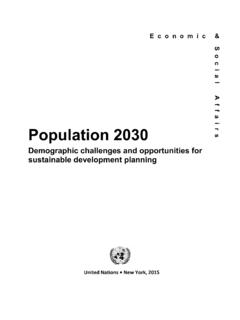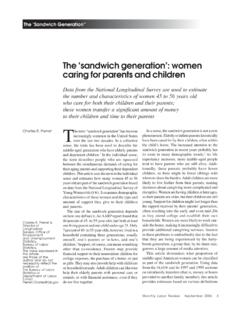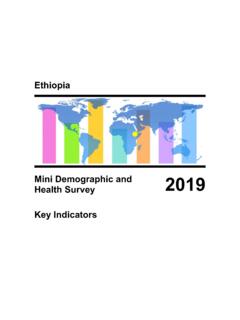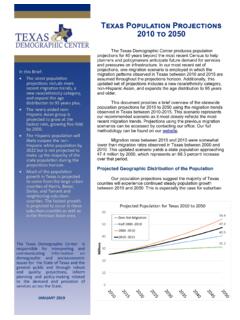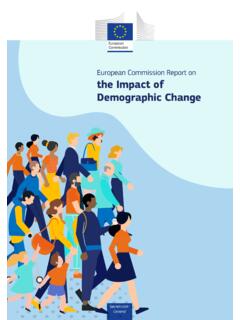Transcription of Chapter I Global trends and challenges to sustainable ...
1 Chapter I Global trends and challenges to sustainable development post-2015A more challenging context for Global development Significant progress has been made in the new millennium in achieving Global develop-ment goals. Poverty was decreasing in all regions of the world, at least until the onset of the Global financial crisis, underpinned by strong economic growth in developing countries and emerging economies. As a result, the first target of the Millennium Development Goals halving the proportion of people living in extreme poverty globally has already been met. Improvements in school enrolment rates and health outcomes demonstrate similar progress in the dimension of social development.
2 Summary yThe Global community has made great strides in addressing poverty, but a mere con-tinuation of current development strategies will not suffice to achieve sustainable development. Economic and social progress remains uneven, the Global financial crisis has revealed the fragility of progress, and accelerating environmental degrada-tion inflicts increasing costs on societies. yThere are a number of economic, social, technological, demographic and environ-mental megatrends underlying these challenges a deeper globalization, persistent inequalities, demographic diversity and environmental degradation to which a sustainable development agenda will have to respond.
3 YThese trends influence and reinforce each other in myriad ways and pose enormous challenges . Urbanization is proceeding rapidly in developing countries, globalization and financialization are perpetuating inequalities, while exposing countries to great-er risks of contagion from crises, and food and nutrition as well as energy security is threatened by competing demands on land and water, as well as environmental degradation. yMost important, environmental degradation has reached critical levels. Business as usual is therefore not an option, and sustainable development will require trans-formative change at the local, national and Global levels.
4 2 World Economic and Social Survey 2013 Nonetheless, a mere continuation of current strategies will not suffice to meet all the Millennium Development Goals by their 2015 deadline and to achieve sustainable development after 2015. In important areas, development is falling short and targets will be missed, including the reduction of hunger, vulnerable employment and maternal mor-tality, and improvements in the lives of slum dwellers, among others. Even where Global goals have been reached, there are wide disparities between and within countries. Thanks in part to the remarkable growth rates in Asia, the region has made a large contribution to the achievement of Global goals.
5 Other regions, and particularly the least developed countries within them, have been less successful. Within countries, economic growth was frequently accompanied by rising income inequality, and the very poor and those dis-criminated against owing to their sex, age, ethnicity or disability have benefited least from overall progress (United Nations, 2011a). Income inequality is mirrored by very unequal social development and access to health services and education. Such intragenerational inequalities pose an equally important challenge to sustainable development, which is primarily associated with intergenerational equity.
6 The fragility of progress became apparent during the food, fuel and financial crises in 2008 and 2009. The Global recession of 2009 was triggered by a Global financial crisis engendered by the financial systems of developed countries, engulfing their finan-cial and banking sectors. The resulting shock to economic activity passed through the Global economy quickly, with international trade, investment and other financial flows collapsing. The recession and the slow subsequent recovery have increased unemployment worldwide and have slowed or partly reversed the decline in poverty.
7 The fact that the Global financial crisis coincided with a peak in food and energy prices aggravated its im-pacts in many countries. Food prices had risen rapidly since 2003, largely driven by rising energy prices and the increased production of biofuels, which became competitive owing to very high oil prices. Exacerbating factors such as extreme weather events in Australia, Ukraine and countries in other regions of the world, as well as increased speculative ac-tivity in commodity markets, highlight the intertwined risks between the three crises and the multidimensional nature of the challenges they posed (Headey, Malaiyandi and Fa n, 2010).
8 Last, accelerating environmental degradation indicates that the world is facing a strong sustainability challenge; that is to say, there are limits to the substitutability of certain forms of natural capital, and thus to the extent to which technologies will be available to overcome environmental and planetary challenges in future (Ayres, 2007). As many forms of this natural capital are absolutely essential to human survival in the long run, its preservation is critical. A future Global agenda has to address this strong sustainability challenge and facilitate transformative change at all levels local, national and Global .
9 Underlying Global megatrends These challenges to sustainable development are driven by broad underlying economic, social, technological, demographic and environmental megatrends. Megatrends are under-stood in this context as major shifts in economic, social and environmental conditions which change societies and substantially impact people at all levels. Both the progress in development that has been achieved in recent decades and its uneven nature are tied intrinsically to changes in the Global economy and globalization. Rising inequalities, the food, fuel and financial crises, and the breaching of planetary boundaries have made clear that a mere continuation of current strategies will not suffice to achieve sustainable development after 20153 Global trends and challenges to sustainable development post-2015 Many countries have benefited from access to Global markets and the spread of knowledge and technology, but others remain marginalized.
10 Tighter trade, investment and financial links have also increased interdependence between countries and led, particularly in combi-nation with financialization, to greater risks of contagion in times of crisis. At the same time, economic growth has been accompanied by rising income inequalities in many countries. In the years ahead, extremely diverse population dynamics have the potential to further exacerbate inequalities, both in developing and developed countries, and at the Global level. With countries at different stages of the demographic transition, further population growth, urbanization and rapid ageing put major stresses on the national infra-structure and health and education systems.










